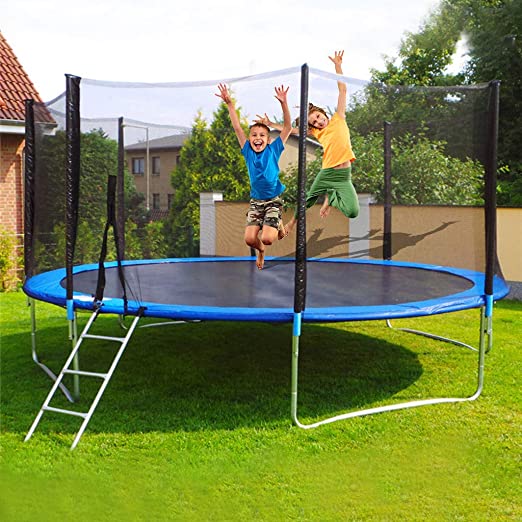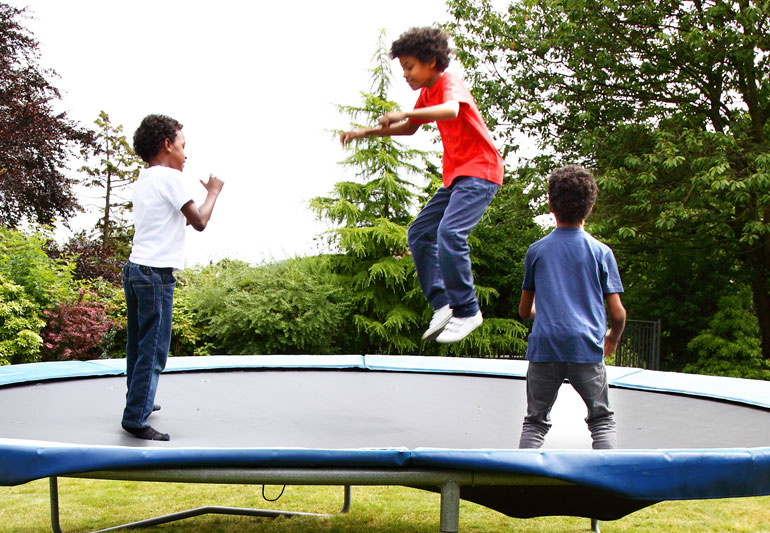Jumping on a trampoline works out your entire body. Bouncing creates a g-force that improves in muscular growth and fat loss.
This tones your entire body, including your legs, thighs, arms, hips, and stomach. It also helps you to improve your agility and balance!
People usually equate exercise with going to the gym or riding a bike, but today we’ll look at all of the trampoline health advantages and how jumping on one may help you lose weight, among other things.
How Does Jumping Work?
When compared to other kinds of exercise, jumping on a trampoline or rebounding offers distinct advantages. It includes enhancing our G-force, which is the gravitational force forced on the body. Each time you jump on the trampoline, you will experience acceleration and deceleration. All 638 muscles contract and relax alternately, toning the whole muscular system.
There are many other sorts of workouts that target certain muscles, but this is the only one that works every muscle in the body. You don’t have to take your feet off the trampoline. Simple bounces have a lot of advantages. The higher the jump, the greater the G-force required to bring the jumper to the mat, resulting in a stronger effect on each muscle and cell. The top 27 reasons why jumping on a trampoline is healthy for your health are listed below.
1. A Fun Way to Lose Weight and Stay Fit
Rebounding exercise is 68 percent more efficient than jogging, according to NASA’s Journal of Applied Physiology. According to a NASA research, a 150-pound person who spends an hour on a rebounder burns more calories than the same person who jogs for an hour. Rebounding on a trampoline is a metabolic-supporting workout since you can still breathe easily if you bounce at a modest pace. It gets you moving without putting too much strain on your metabolism.
2. It Is Good For Your Heart
It gives your heart a hard aerobic exercise by increasing the pace at which it pumps blood around your body. It also helps to build the muscles that are necessary for a healthy cardiovascular system.
3. Jumping Helps To Prevent Osteoporosis By Increasing Bone Density
Rebounding on a regular basis can assist elderly persons in retaining their bone density and mass. In addition, it works well to prevent osteoporosis. When bones are stressed, they become stronger, and when they are not stressed, they get weaker. Working against gravity is the greatest method to do this. In just 14 days in zero gravity, astronauts can lose up to 15% of their bone and muscle mass. NASA’s principal method for letting astronauts rebuild their bones and reverse osteoporosis is rebounding.
When you jump on a trampoline, the G-force impact is felt throughout your entire body. However, unlike other workouts, rebounding improves bones and muscles without putting weight-bearing joints, including the knees, ankles, hips, and back at risk of injury.
4. Jumping Improves Lymphatic Circulation, Which Helps In Detoxification
The lymphatic system is cleansed by jumping on the trampoline, which promotes eliminating toxins from the body. We live in an unparalleled period in which we are regularly exposed to high levels of environmental pollutants and chemicals in our food, air, and water. Our bodies’ capacity to adequately rid these poisons is critical to our overall health. A toxic body can lead to repeated infections as well as major metabolic problems like cancer. Detoxification relies heavily on our lymphatic system.
The lymphatic system, unlike the circulatory system, which uses a heart to pump blood throughout the body, does not have a pump and relies on body motions to circulate. Because lymphatic fluid moves upward, vertical motion activities like trampoline jumping are more effective than horizontal motion workouts like walking and jogging in pumping lymph fluid. As a result, rebounding regularly aids in bodily cleansing, allowing you to retain a healthy and young physique.
5. Promotes Body Detoxification and Cleansing
The body’s natural detoxifying system is helped by trampoline exercise. Rebounding is a type of workout in which you reach weightlessness at each jump and landing apex. This change in gravity is beneficial to every muscle and cell in the body and the lymphatic system.
6. Jumping Strengthens All Of The Body’s Cells
Rebounding essentially causes all of the body’s 37 trillion cells to move up and down. Gravity and G-force stress lead each cell to adapt to the higher load by gaining strength, resulting in enhanced cell energy and mitochondrial performance. The importance of cellular health to our overall health cannot be overstated. Cells become vulnerable to DNA damage when they malfunction. Chronic and degenerative illnesses are preceded by mutated cells. Constitutional strength and strong health are inextricably linked when each cell functions harmoniously and adequately.
7. It Boosts The Immune System’s Performance
The immune system relies heavily on the lymphatic system. It is a viral bacterium, illness, and infection defense system. Lymph comprises many lymphocytes, a kind of white blood cell that is important for combating infections in the body. Rebounding causes the lymphatic system’s valves to open and close simultaneously, boosting fluid flow by up to 15 times. As a result, immunity is boosted, toxins are removed, and the aging process is slowed.
8. Helps to Reduce Cellulite
On a trampoline, bouncing is similar to pumping your body. Rebounding encourages the thyroid gland to begin cleansing itself and the lymphatic system as a whole of accumulated fat. The most effective approach to getting rid of cellulite is to exercise on a trampoline.
9. Increases Bone Mass and Strengthens Skeletal System
The greater G force on the bones experienced during rebounding has been found in studies to strengthen them without addressing problems such as shin splints and fractures. Trampoline activity improves bone density, which can help avoid diseases like osteoporosis. In addition, it helps to strengthen joints, tendons, and ligaments, which may help to reduce the risk of some types of arthritis.
10. Increases Cell Energy By Increasing Oxygen Circulation
While rebounding, there is a considerable increase in “bio-mechanical stimulation.” This implies that bouncing on a trampoline is better for your body than jogging. NASA now uses trampoline workouts to recondition astronauts following spacewalks to avoid muscle and bone degradation.
11. Boosts Mitochondrial and Cellular Energy Production
Due to the increased need for energy by the body’s cells, rebounding on a trampoline will naturally raise the mitochondrial count in each cell. This will enhance both your available energy and your body’s capability to use it. This implies that trampoline activity kick-starts your metabolism, and you’ll lose weight long after you’ve done exercising. Furthermore, you will be energized throughout the day.
12. Workout Your Body Without Excessive Pressure on Your Feet and Legs
Many aerobic workouts put an excessive amount of strain on the joints, foot, and legs. Jumping or running on a trampoline is more effective since you may work out for extended periods of time without becoming weary or experiencing joint discomfort. In addition, jumping on a trampoline produces a G force that increases body tone and works the entire body.
13. Improves Posture and Balance
Rebounding on a trampoline activates the vestibule in the middle ear, which improves balance naturally.
14. Reduces Body Fat and Increases Muscle to Fat Ratio
Trampoline workouts strengthen the legs, thighs, belly, arms, and hips while also improving agility and balance. When you recover, the moderate detoxification that happens increases fat loss.
15. Jumping Helps Gut Health And Digestion
The regular up-down motion of jumping on a trampoline aids digestion by stimulating the contraction and relaxation of the muscles that make up the digestive system. Improved digestive peristalsis implies the body can more efficiently process and absorb nutrients. This will aid in the treatment of nutritional deficiencies, which are common in patients with weakened digestive systems. In addition, the body would have the required resources for self-healing and regeneration if it received the nutrients it needs. Furthermore, activated peristaltic waves in the intestines help food pass through faster and waste to be released, preventing constipation.
16. Improves the Cardiovascular System
In the same manner that rebounding promotes lymphatic circulation, it also increases blood circulation and the cardiovascular system. Rebounding also prevents chronic edema by reducing blood pooling in the veins.
17. It’s Gentle On The Joints
Because the bouncy mat absorbs the energy when you land, trampolining is a low-impact workout that prevents jarring of your ankles, knees, hips, and spine. As a result, it’s less demanding on your joints than jogging or running.
18. Helps to Reduce and Combat Varicose Veins
Rebounding is a natural approach to get rid of varicose veins for good. Rebounding regularly improves blood circulation, which reduces the strain on your veins and eliminates the irritation and pain associated with varicose veins.
19. Enhances The Effects Of Other Workouts
Combining rebounding with other forms of exercise, like strength training and weight lifting, has been shown to provide better outcomes.
20. It Helps With Co-Ordination
To keep balance, accomplish varied postures, leap high, and prepare for the next position – all at the same time – you must be able to concentrate intensely. This improves motor skills and coordination when practiced.
21. Provides Low-Intensity, Limited Cardiovascular Exercise
When you bounce, the trampoline surface absorbs the impact, lowering the chance of muscle and fiber injury. In addition, when bouncing, the gravitational force measured at the ankles, back, and forehead is more evenly distributed.
22. Jumping Improves Vision By Strengthening Eye Muscles
Due to the effects of higher G-force on every area of the body, jumping on the trampoline also helps strengthen your ocular nerves and eye muscles. Unfortunately, Singapore has the highest rate of myopia among our youth in the world. Nearsightedness, or myopia, has reached frightening levels in many regions of East Asia. Many variables may have contributed to the trend, but frequent rebounding can help us battle poor vision. Eyes are semi-muscular organs that, like every other muscle in the body, must be trained. Without exercise, our eye lenses can get out of shape like the rest of our bodies. Rebounding aids in the regeneration of the cells that make up the eye lenses, allowing them to regain their former form and function.
23. It Aids In Body Toning
Because you engage your core muscles to keep balanced when trampolining, you work a range of muscles, including your legs and stomach. Regularly bouncing on a trampoline might help keep your stomach and bottom toned.
24. Helps in Preventing And Eliminating Cancer
Rebounding improves lymphatic fluid circulation, which aids in the destruction of malignant cells in the body. The fluid gathers waste items, germs, damaged cells, damaged malignant cells if they are present, and drains them through the lymphatic channels.
25. Jumping Improves Lung Capacity And Oxygen Intake By 25 Percent
The most important nutrient for the human body is oxygen. Jumping helps to enhance energy by circulating oxygen throughout the body. Disease germs and renegade cells cannot thrive in a highly oxygenated body because they are anaerobic, meaning they cannot exist in a high-oxygen environment. Jumping on the trampoline regularly energizes your body and boosts your resistance to colds, flus, and other illnesses.
26. Jumping Helps To Boost Mental Capability and Mental Well-Being
Rebounding on a regular basis promotes blood circulation. This permits the brain to get an excess of fresh oxygen, which improves mental sharpness and attention. Cross patterning activities on the trampoline, which include repeating movement on one side of the body on the other, improve communication between the two hemispheres of the brain. This boosts brain capacity and has been shown to aid reading and to write in youngsters.
Jumping on the trampoline also makes you feel better. It causes the release of endorphins or “feel-good” chemicals, improving mood and increasing optimism and self-confidence.
27. Relieves Women’s Fatigue and Menstrual Discomfort
Rebounding is important for a healthy endocrine system because it detoxifies excess hormones and poisons.
Final Thoughts
Anyone can jump on the trampoline since it is so simple. Gentle bouncing on the trampoline mat brings all of the health benefits of rebounding and is suited for both the young and the elderly.
Frequently Asked Questions
Running Vs. Trampoline?
Running for 30 minutes burns between 200 and 300 calories. Bouncing up and down on your trampoline burns equal amounts of calories. If you combine other activities with trampoline jumping, you might burn twice as many calories.
What Muscles do Trampolines Work?
Jumping on a trampoline works out the entire body, and the g-force produced by bouncing helps to develop muscle fast and burn fat.
Legs, thighs, arms, hips, and stomach muscles are all worked out on a trampoline. It also helps you to improve your agility and balance. To overcome gravity and propel you forward, your leg muscles must work hard.
Jumping with intensity and repetition causes your muscles to contract and release more frequently than practically any other workout. This boosts their strength while also toning them. So Trampolining does more than strengthen your legs.
You strengthen your stomach and core muscles by twisting yourself to stay balanced and move in the air. Then, each time you jump and land back on the mat, your abs and back muscles tighten simultaneously. Add some easy trampoline exercises to your bounce, and you’ll be able to work out your entire body!
Remember that trampoline exercises a variety of muscles, including joints, tendons, and ligaments.
It’s also an excellent workout for persons with mild arthritis since it can help relieve joint discomfort.
What Is The Definition Of Rebounding?
Rebounding is a type of cardiovascular exercise that is usually done on a small trampoline. “When compared to a bigger trampoline you could see outside, rebounders are generally smaller and firmer, which allows for a greater bounce,” explains Dong. However, he believes that a trampoline isn’t lacking in intensity despite its modest impact. Dong explains, “It covers every single region of your body and can work up a tremendous sweat in just 30 minutes.” “It’s efficient, but it’s also a lot of fun.”




